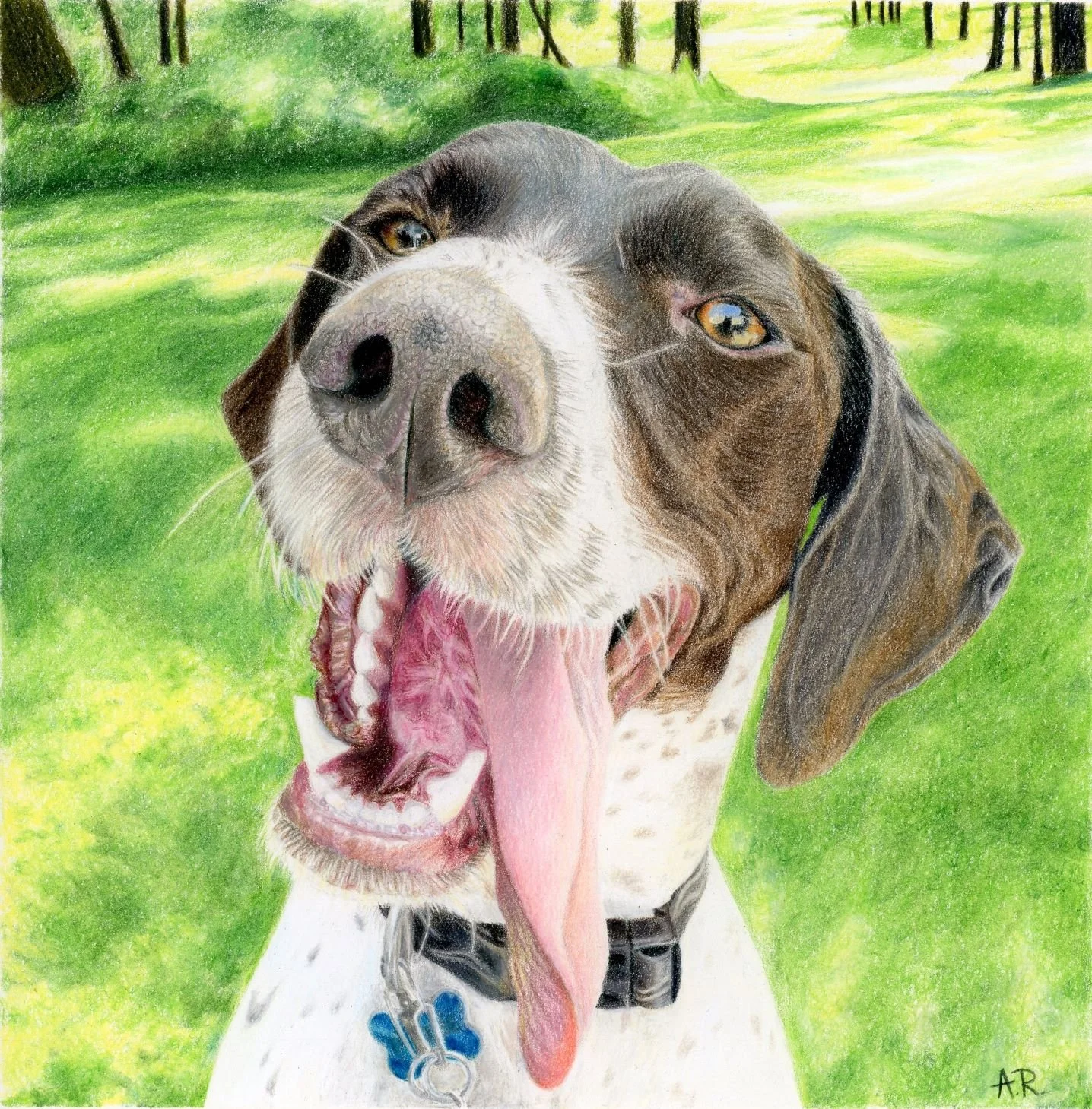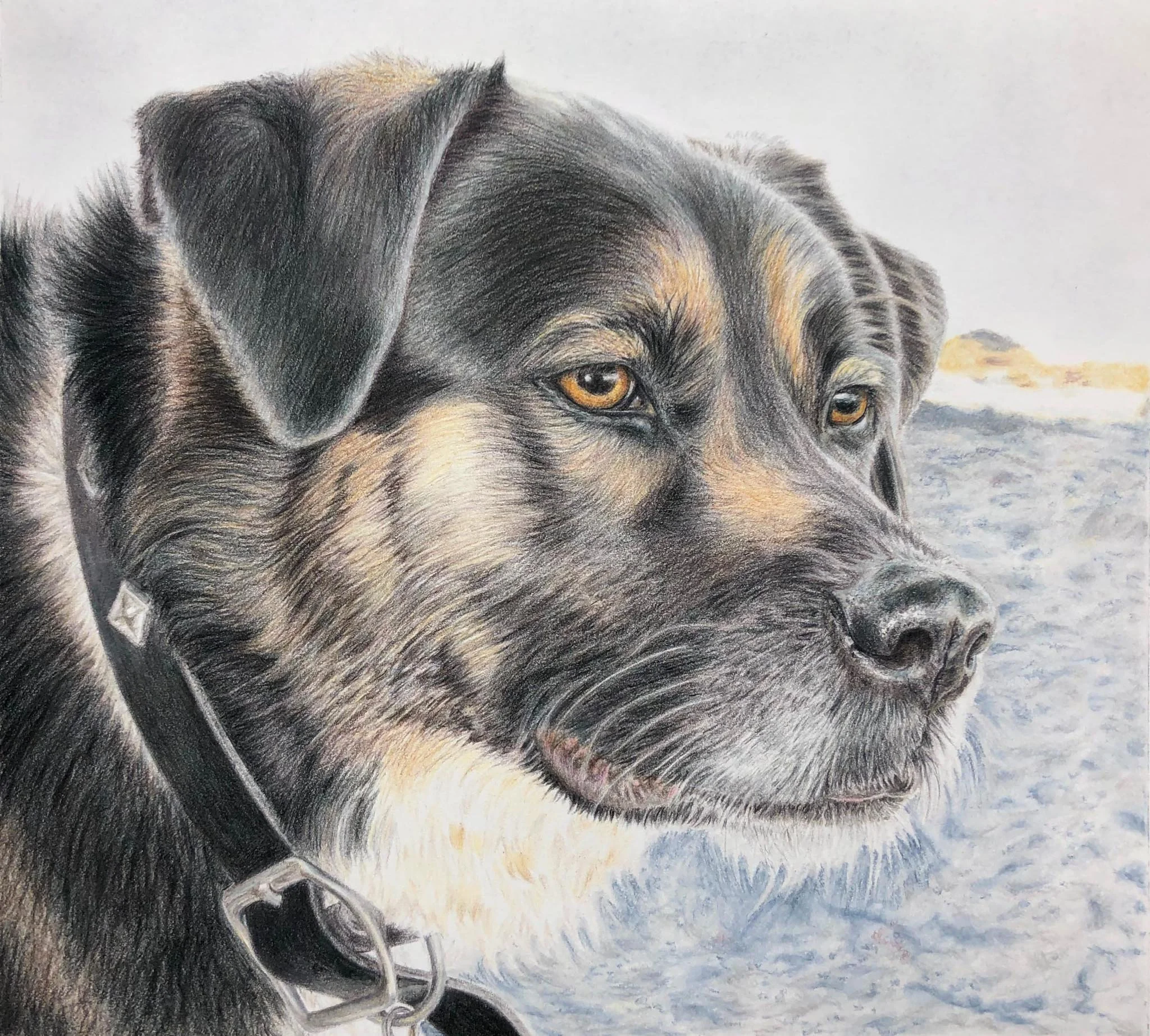5 Colored Pencil Paper Types Explained
For “Pheobe” I used Prismacolor Premier colored pencils on Strathmore Colored Pencil paper, series 400.
I started my journey of learning how to create works of art with colored pencils in 2018. I was overwhelmed by all of the paper choices. Here are 5 types of papers that you can use including techniques that work best with each surface.
You can use any kind of paper that you want for colored pencils. Artists experiment and draw on watercolor paper, pastel paper, and smooth paper, to name a few. Each paper type will give you different results.
The main differentiation between each type of paper is the tooth of the paper.
As I explain papers and supplies, I provide affiliate links. I get a tiny portion if you order through those links.
Okay, let’s get to it!
What is paper tooth?
Every paper type has its own size of paper tooth. This refers to the hills and valleys that are in every paper surface as a result of its manufacturing. If there are shallow hills and valleys the paper has little to no tooth and the paper is smooth. Think about a piece of printer paper as an example of smooth paper.
If a paper has a lot of hills and valleys it has more tooth to it. Think about a piece of sandpaper, although you wouldn’t draw on it. It has a lot of tooth. An example of a high tooth paper that you may draw on would be Clairefontaine Pastelmat.
The degree of tooth in a paper will determine which techniques you can use and what effects you can create on that surface. In general, you can get more layers on a higher tooth paper than a lesser tooth paper. I find that more layers create a richer depth of color, but some artists prefer a lesser tooth paper. You will have to experiment to see what gives you the best results.
Strathmore Colored Pencil Paper, series 400
This is an excellent medium-toothed paper. The Strathmore Colored Pencil Paper, series 400 is what I would recommend beginner colored pencil artists buy. It is very economical at $13 for a 9x12” pad with 30 sheets, and people of all skill levels can create beautiful pieces using it.
The series number tells you about the quality of the paper. The higher the number equals a higher quality surface. 400 series is a professional-grade quality, and so you can feel good about drawing commissions on this paper. 500 is the highest series and therefore the best quality.
You can use wax-based and oil-based pencils on this paper, but my preference is to use Prismacolor Premiers. The wax-based pencil colors are more saturated, and you can create a lovely piece by burnishing your layers.
Burnishing is when you go over the top of the layers you have added by applying more pressure. It mixes the colors you lay down and removes the grainy look of the paper.
I rendered the grass in the above piece (“Phoebe”) by adding at least 6 to 7 layers and then burnishing with a white or light green pencil. I repeated this process until I was satisfied with the results. As you can see, the end drawing is saturated with color and not grainy.
2. Strathmore Bristol smooth paper
Just so you are aware of the terms- Bristol refers to a type of paper that is made of smushing together layers under very high pressure. The result is a thicker paper with two sides you can draw on. There are different types of Bristol paper.
Bristol smooth paper is at the extreme end of the low-tooth paper spectrum. It doesn’t have much tooth at all, and therefore it won’t hold many layers of pencil.
I drew a portrait of my dog, Nessa, on Strathmore Bristol smooth paper, series 500. I have also drawn graphite portraits on this paper.
It costs about $26 dollars for a pad of 15 sheets. This 500 series is made up of 100% cotton, and that is why it is more expensive. I like that the paper of this brand is white, but that is just a preference. If I’m not doing a background I prefer a white background to cream.
Some artists have success with this paper, although I will say that it’s not my favorite for colored pencils. I found I couldn’t get my values dark enough. I do like it for graphite drawings, however. You may want to play around with a piece of it to see if it suits your style.
3. Bristol vellum paper
The second type of Bristol paper I will discuss is vellum. Vellum is a Bristol paper that has a medium tooth to it. This type of paper would be a step up from #1’s Strathmore colored pencil paper. It costs a bit more, but it is thicker paper and of a higher quality.
I drew the cat below on Canson Bristol vellum paper, but I can’t find the link to the specific pad of paper because mine is from 2008.
This Strathmore Bristol Vellum Paper, series 500 would be comparable. It runs around $20 for a pack of 15, size 9 x 14”. This paper is also white.
Because this paper is similar to the colored pencil paper in #1, you can do the same burnishing techniques on this surface.
You can also try indenting techniques to create voided areas that will prevent the application of color. For example, you may want to indent spaces for cat whiskers or hairs using an indenting tool. Regrettably, I did not do that in the drawing below. It probably would have been easier if I had. Instead, I mapped out white areas for the lines of fur and whiskers and drew around them.
I did use solvent to mix layers for my background in the drawing below. Bristol vellum paper is definitely thick enough to handle solvents if you choose to use them on your piece. I used Gamsol, an odorless mineral spirit. I painted a tiny bit of it over top of my background layers to mix them and eliminate the grain of the paper.
This kitty was drawn using Polychromos on Canson Bristol Vellum paper.
4. Clairefontaine Pastelmat
I love Clairefontaine Pastelmat. I love it so much I have written two previous blogs on it: The Pros and Cons of Pastelmat and 5 Tips for Using Pastelmat.
Pastelmat comes in a lot of sizes and colors. When I first started using it I bought a pad that had multiple colors in it. That’s probably the best way to try it out because you can test the different colors to see which ones you like.
It is a more expensive paper. A pad of 12 sheets can run you around $42, depending on the color and size. You can also buy it in boards or single sheets. See my pro and con blog for more details on Pastelmat.
My favorite type of pencils on this paper are oil-based pencils like Faber-Castell Polychromos and Caran d’Ache Pablos. I like to put down some layers of these types of pencils and then use a dry paintbrush to soften the appearance and get rid of the grainy look of the paper. Then I add additional layers until I’m satisfied with the look.
Because this paper has a lot of tooth it takes a lot of layers. This is a benefit if you are trying to create a depth of color.
You can also draw lighter marks on top of darker colors on this paper, which makes this surface unique from the others.
I also like to remove pigment to create texture when creating with Pastelmat. I do that with either a kneaded eraser or scotch tape. It’s effortless to remove oil-based pencils in this manner on Pastelmat. The wax-based pencils tend to be more sticky and harder to remove.
This paper is also very thick and will handle pastels and liquid-based media. It is a hearty paper that is worth the price, in my opinion.
“Jackson” was created using Polychromos on Pastelmat.
5. Drafting film
Grafix Drafting Film is a really fun surface to draw on. It’s not a paper, because it’s a film. It is transparent so you need to draw with a piece of paper behind the drafting film so you can see what you are doing. Then when you have your drawing matted, you will need to mount it with a piece of paper behind it.
I have only used the Grafix Drafting Film, but people say that the Duralar brand is just as good. The Grafix is about $5 for an 18” x 24” sheet. Buy the .005 double-sided matte sheet of that from Blick’s. A pack of the Duralar with 25, 9” x 12” sheets runs about $19.
Drafting film is a low-tooth surface, so you can’t add a lot of layers. But that’s one of the things that I like about it. It’s refreshing to get to the point sometimes when you work with such a slow medium. You are forced to create a work using fewer layers with drafting film.
That said, you will have to be careful with your pencil strokes. You have to be very gentle and consistent so that you can’t see the lines.
Another benefit of drafting film is that it is the most forgiving surface. You can totally erase mistakes. You can also use erasers like the Tombow mono eraser to create texture in your piece.
You can also use the Slice Pen Cutter Tool for creating hair lines, like in the drawing of the bunny below.
Most people enjoy drafting film. So if you are looking to switch up your routine, give it a try.
Conclusion
The number of paper types for colored pencils can be daunting. Once you learn what each paper is capable of it will be easier for you to decide on which type to try for your next piece. Decide on the subject and your vision for your piece, and use that information to select a paper that will work for you.
Did I miss a paper that you use? Tell me about it in the comments :)






